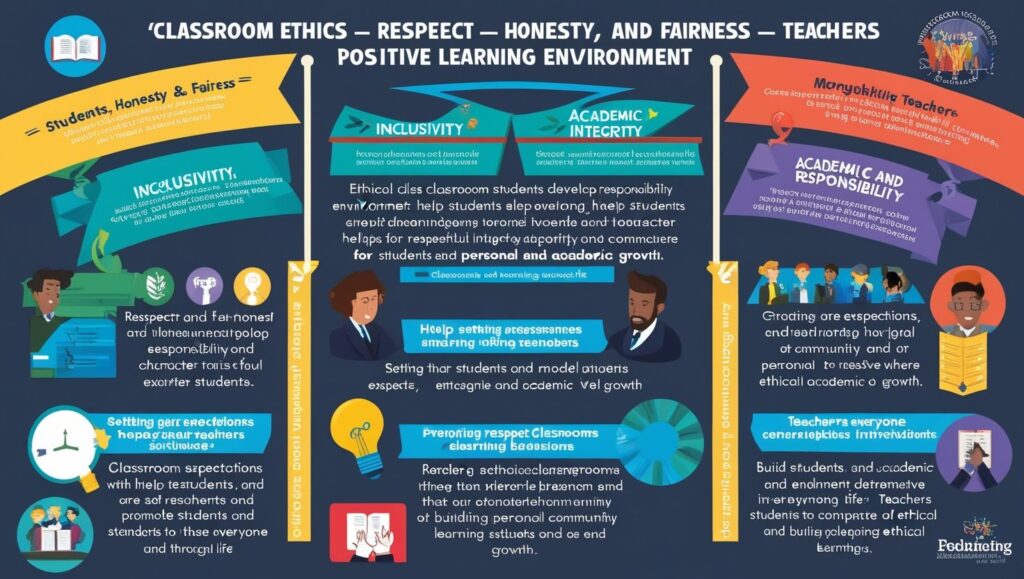Introduction
Classroom Ethics, Ethics in the classroom serve as the backbone for a conducive learning environment, fostering mutual respect, honesty, fairness, and responsibility. As students engage in educational activities, ethical principles guide their actions, interactions, and decision-making processes. These principles are not only fundamental for academic success but also cultivate character traits that shape responsible citizens in the future. This article explores the significance of classroom ethics, the roles of teachers and students, ethical dilemmas, and best practices for establishing a strong ethical foundation in educational settings.
The Importance of Classroom Ethics
Classroom ethics represent the shared values and rules that govern behavior within the educational environment. Ethical conduct in the classroom promotes respect, inclusivity, and positive interaction among students and teachers, ultimately contributing to a productive learning experience. A study by Kohn (2006) highlights that an ethical classroom environment nurtures students’ sense of belonging, reduces behavioral issues, and boosts academic performance. By learning the importance of integrity, students are better prepared to handle responsibilities beyond the classroom.
1. Fostering Mutual Respect and Inclusivity
Respect is one of the core pillars of classroom ethics. It extends beyond polite behavior, encompassing an appreciation for the diverse backgrounds, abilities, and perspectives students bring into the classroom. Teachers, as role models, play a pivotal role in setting the tone for respect. They establish classroom rules that encourage respectful interactions, address discrimination or bias, and promote a safe space for all voices.
2. Encouraging Honesty and Academic Integrity
Honesty and integrity are critical in academic settings. A classroom that prioritizes ethical behavior fosters a commitment to truthfulness, even when facing challenging situations. Academic integrity entails submitting original work, avoiding plagiarism, and giving credit to sources used in research. The teacher’s role in reinforcing academic honesty is vital, as it prevents academic misconduct, promotes fairness, and builds trust between students and teachers.
Establishing a culture of academic integrity also prepares students for real-world expectations. According to McCabe, Butterfield, and Treviño (2001), students who develop strong ethical foundations in school are less likely to engage in dishonest behaviors in the workplace, underscoring the long-term impact of classroom ethics on personal and professional development.

Ethical Roles of Teachers and Students
Classroom ethics are not the responsibility of teachers alone; both teachers and students contribute to upholding ethical standards.
1. Teachers as Ethical Role Models
Teachers hold a position of authority and influence, making them essential role models for ethical behavior. By demonstrating respect, fairness, and empathy, teachers set an example for students to emulate. Research by Lickona (1991) shows that students learn ethical behavior more effectively by observing and interacting with ethical role models. When teachers consistently display fairness in grading, patience in handling conflicts, and honesty in communication, they reinforce ethical principles among students.
Furthermore, teachers are tasked with creating an ethical framework for the classroom, which involves establishing clear expectations and consistently applying rules. Teachers can integrate ethical discussions into lessons, enabling students to explore moral dilemmas and develop their understanding of ethical decision-making.
2. Students’ Responsibility in Maintaining Ethics
While teachers guide ethical behavior, students have a responsibility to adhere to these values. Students contribute to a respectful and inclusive environment by participating actively, listening to peers, and treating everyone with courtesy. Encouraging students to take ownership of classroom ethics fosters a collaborative atmosphere, making students accountable for their actions.
Student-led initiatives, such as honor codes or peer mentoring, can enhance ethical awareness within the classroom. Peer support systems, where older students mentor younger ones on academic integrity and respect, empower students to uphold ethical principles collectively.
Ethical Dilemmas in the Classroom
Ethical dilemmas in classrooms can challenge both students and teachers, particularly when there are competing values at play. Common dilemmas include fairness in grading, handling confidential student information, and addressing incidents of cheating.
1. Fairness in Assessment and Grading
Ensuring fairness in grading is a priority for educators, yet it often presents ethical challenges. Teachers must avoid biases based on students’ previous performances, behavior, or personal characteristics. Ethical grading practices involve clear rubrics, transparent criteria, and constructive feedback, ensuring that every student has an equal opportunity to succeed.
2. Confidentiality and Privacy
Teachers frequently encounter situations requiring confidentiality, especially regarding students’ personal issues. Maintaining confidentiality is crucial to building trust with students and their families. However, situations arise when confidentiality conflicts with mandatory reporting requirements, particularly in cases involving student safety. Ethical frameworks, such as those outlined by the American Psychological Association (APA), provide guidance for navigating these delicate situations.
3. Addressing Academic Dishonesty
Dealing with cheating and plagiarism is another ethical challenge in educational settings. Teachers must balance maintaining academic standards with fostering a supportive learning environment. Addressing dishonesty requires discretion and understanding of students’ motivations, as punitive measures alone may not address underlying issues. Emphasizing academic integrity through discussions, ethical guidelines, and educational resources can prevent dishonesty more effectively than punishment.

Best Practices for Promoting Classroom Ethics
To build an ethical classroom, educators can implement several effective strategies that encourage ethical behavior among students.
1. Creating Clear Guidelines and Expectations
Establishing a clear set of ethical guidelines from the outset helps students understand expectations regarding behavior, academic honesty, and respect. Classroom contracts or honor codes can serve as tangible reminders of these standards. When students are aware of and agree to ethical guidelines, they are more likely to follow them.
2. Integrating Ethics into the Curriculum
Ethics can be woven into various subjects, encouraging students to reflect on moral issues related to science, history, or literature. For instance, discussing the ethical implications of scientific discoveries or historical events enables students to critically analyze ethical dimensions beyond the classroom. Ethical dilemmas, case studies, and group discussions are valuable tools for fostering critical thinking and ethical reasoning.
3. Encouraging Open Communication and Feedback
Open communication builds trust between teachers and students, creating a comfortable space for discussing ethical issues. Regular feedback sessions allow students to voice concerns and seek clarification on ethical expectations. Encouraging questions about fairness in grading, academic integrity, and respectful behavior ensures transparency and helps students internalize ethical principles.
4. Recognizing and Rewarding Ethical Behavior
Positive reinforcement can be instrumental in encouraging ethical conduct. Teachers can acknowledge students who demonstrate integrity, respect, and empathy. Recognitions, awards, or simple verbal affirmations can motivate students to maintain ethical behavior. By valuing ethical conduct as much as academic achievements, educators convey the importance of integrity and respect.
Conclusion
Classroom ethics lay the groundwork for respectful and inclusive learning environments where students feel valued, empowered, and motivated to excel. By fostering respect, honesty, and responsibility, ethical classrooms shape students into individuals capable of making informed and compassionate choices. As educators and students collaborate to uphold ethical standards, they create a classroom culture that transcends academic boundaries, impacting communities and society at large. Establishing a strong ethical foundation in classrooms not only supports students’ personal growth but also contributes to a more ethical, fair, and inclusive world.
References
- Kohn, A. (2006). Beyond Discipline: From Compliance to Community. ASCD.
- Kohlberg, L. (1981). The Philosophy of Moral Development: Moral Stages and the Idea of Justice. Harper & Row.
- Lickona, T. (1991). Educating for Character: How Our Schools Can Teach Respect and Responsibility. Bantam Books.
- McCabe, D. L., Butterfield, K. D., & Treviño, L. K. (2001). Cheating in Academic Institutions: A Decade of Research. Ethics & Behavior, 11(3), 219-232.
- American Psychological Association (APA). (2020). Ethics Code of Conduct.

7 thoughts on “Classroom Ethics”
Comments are closed.